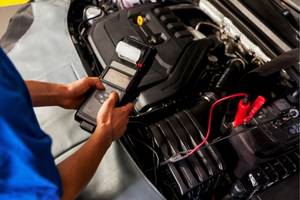Introduction
Are you a Ford owner struggling with sudden drops in your vehicle's performance or a constant Check Engine light that just won't go away? If so, you might be dealing with a malfunctioning Powertrain Control Module (PCM). This essential component manages several aspects of your Ford’s performance, from shifting gears to fuel efficiency. If your vehicle is exhibiting signs like unstable shifting, decreased fuel efficiency, or failure to start, it's time to consider replacing the PCM. Join us on a detailed journey through the process of Ford PCM replacement, from finding the need for a new module to successfully installing and testing it. This guide will help you navigate this essential repair with confidence and precision.
1. Identify the Need for Ford PCM Replacement
If you've been driving your Ford for a while, chances are you've become quite aware of its hums and roars. Suddenly, if you notice anything out of the ordinary, it might be a sign that your Ford PCM needs a check. Here's how you can identify the need for a Ford PCM replacement:
Unexpected Shifting Issues: Is your Ford starting to feel like a wild horse, shifting gears unexpectedly, or refusing to shift at all? Your PCM might be sending out an SOS!
Decreased Fuel Efficiency: Have you noticed that your Ford is now guzzling gas like a thirsty marathoner? It's probably not your driving; it could be a sign that your PCM needs replacing.
Check Engine Light: The check engine light is like a pimple of car problems — it could mean anything. But if it refuses to go off even after fixing other potential issues, your PCM might be the culprit.
Failed Emissions Test: If your Ford just failed an emissions test, the PCM might be failing to regulate the exhaust system correctly. It's time to consider a Ford PCM replacement!
Car Doesn't Start: Of course, if your Ford refuses to start altogether, it might be a clear sign that your PCM needs some serious TLC.
Identifying the need for a Ford PCM replacement can feel like detective work. But once you've noticed the signs and concluded that a replacement is in order, you're already one step ahead on this journey. Now, put on your detective hat and let's move towards the next clue: selecting the correct Ford PCM.
2. Select the Correct Ford PCM
Now that you've figured out the need for a Ford PCM replacement, it's time to find the perfect match for your Ford. But wait! This isn't a simple "one-size-fits-all" deal. The PCM you choose needs to be compatible with your Ford model and year, like a well-tailored suit.
Before we proceed, remember the golden rule: always cross-verify the PCM's suitability with your Ford model and year. If you end up with an unsuitable PCM, it's a bit like trying to fit a square peg into a round hole — a frustrating and futile work.
So, how do you ensure you select the correct Ford PCM? Here's a simple step-by-step guide:
Know Your Ford: Be aware of your Ford's model, year, and specific engine type. The PCM for a 2010 Ford Escape is not going to play nice with a 2015 Ford Mustang!
Match the PCM Code: Each PCM comes with a specific code. This code needs to match the one on your original PCM. It's like a secret handshake between your Ford and the PCM.
Choose a Reputable Vendor: Not all Ford PCM replacements are created equal. Go for reputable vendors who specifically deal with Ford PCMs. They can guide you towards the right PCM and also assist with any post-purchase issues.
Remember, when it comes to Ford PCM replacement, choosing the right PCM is half the battle won. So, take your time, do your research, and select wisely. Up next, we'll dive into the installation process. It's easier than you think — promise!
3. Install the New Ford PCM
Alright, you've done your homework and gotten your hands on the perfect Ford PCM replacement. Now, it's time to roll up your sleeves and get down to action. Ready? Let's get started!
Disconnect the Battery
Before starting, remember safety first. Disconnect the battery's negative terminal. You don't want any electrical surprises mid-installation, do you?
Locate the PCM
Now, where does this new PCM fit? Well, the location can vary based on your Ford model. Usually, it's in the engine compartment or under the dashboard. Look for a metal box with a lot of wires — bingo, that's your PCM's home.
Remove the Old PCM
With the location sorted, it's time for the old PCM to make way for the new one. Unplug the connectors and remove the bolts holding the PCM. Gently remove the old PCM — remember, no yanking or pulling!
Install the New PCM
Now is the moment you've been waiting for! Install your new Ford PCM. Connect it in the same way the old one was connected. Secure it with the bolts and give it a good look—is everything connected properly? Great!
Reconnect the Battery
Finally, reconnect the battery. Your Ford is now ready to make friends with its new PCM.
And voila — you've successfully installed your Ford PCM replacement! But wait, we're not done yet. It's time to check if everything's working as it should. Are you ready to test your new PCM? Let's move on to the final step.
4. Test the New Ford PCM for Successful Installation
Well done on the installation! But before you hit the road, let's make sure your Ford PCM replacement is ready to roll.
First, take a moment to visually inspect your work. Does everything look connected? No loose wires or bolts? If all seems well, you're good to proceed.
Start Your Ford
Now, let's see how your Ford responds. Start your vehicle. Notice anything unusual or strange? Are there any warning lights on the dashboard that weren't there before? If not, you're on the right track.
Listen to Your Ford
Your Ford speaks to you through sounds. Odd noises can be a sign of trouble. So, listen carefully. Any strange popping, grinding, or hissing sounds? If everything sounds normal, give yourself a pat on the back.
Take a Short Drive
Now, let's take your Ford for a drive. A short drive can help you pick up on any abnormalities. Pay attention to how your Ford drives. Are there any signs of stalling, jerking, or difficulty accelerating? If not, your Ford PCM replacement seems to be a success.
Check Error Codes
Finally, use an On-Board Diagnostics (OBD) scanner to check for error codes. If there are no PCM-related error codes, congratulations! You've successfully replaced and tested your Ford PCM.
And that's it! You've successfully navigated the journey of a Ford PCM replacement. Now, enjoy the smooth ride and peace of mind that come with knowing you've done a job well.
Conclusion
Replacing the Powertrain Control Module (PCM) in your Ford might seem like a frightening task, but with the right knowledge and tools, it’s entirely manageable. From recognizing the symptoms that indicate a failing PCM to selecting the correct replacement and performing the installation, this guide has walked you through each important step. By following these instructions, you can make sure that your Ford returns to its ideal performance. Remember, a well-executed PCM replacement not only restores your vehicle's functionality but also gives you peace of mind knowing you've tackled the issue effectively. So, buckle up and enjoy the smooth drive ahead!
FAQs on
Steps to Successful Ford PCM Replacement in 2025 : Practical Guide
-
1. What are the common signs that my Ford needs a PCM replacement?
Ans.
Common signs include unexpected shifting issues, decreased fuel efficiency, a constant Check Engine light, failed emissions tests, and the car failing to start. These symptoms often indicate that the PCM may be malfunctioning.
-
2. How do I find the right PCM for my Ford model?
Ans.
To find the correct PCM, you need to know your Ford's model, year, and engine type. Make sure the PCM's code matches the code on your original module. Purchasing from a reputable vendor who specializes in Ford parts can also make sure you get the correct PCM.
-
3. Can I replace the PCM myself, or should I consult a professional?
Ans.
Replacing the PCM can be done by a skilled DIYer with basic mechanical knowledge. However, if you’re not sure or uncomfortable with the process, it’s best to talk to a professional mechanic to ensure the job is done correctly.
-
4. How long does it take to install a new PCM in a Ford?
Ans.
The installation process usually takes about 1 to 2 hours. This includes disconnecting the battery, removing the old PCM, installing the new one, and reconnecting the battery. Testing the new PCM might require additional time.
-
5. Will replacing the PCM fix all performance issues in my Ford?
Ans.
Replacing the PCM can address many performance issues related to electronic controls, but it may not resolve all problems. If symptoms continue after replacement, further diagnostics may be needed to identify other underlying issues.
-
6. How can I test if the new PCM is working correctly after installation?
Ans.
Perform a visual inspection to make sure all connections are secure. Start your Ford and listen for unusual noises or warning lights. Take a short drive to check for any abnormal driving behavior. Finally, use an On-Board Diagnostics (OBD) scanner to make sure there are no PCM-related error codes.


